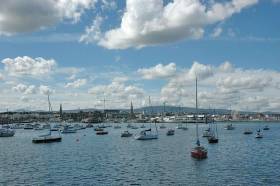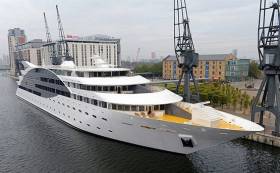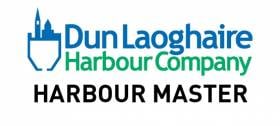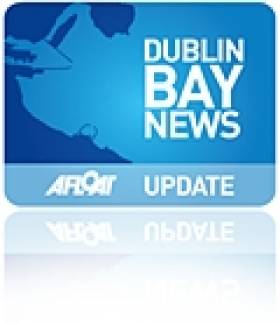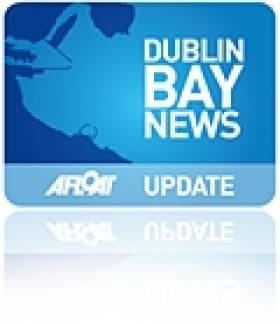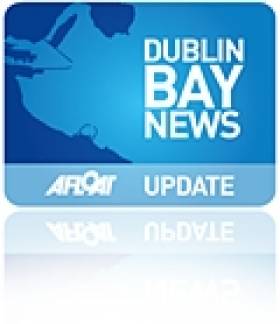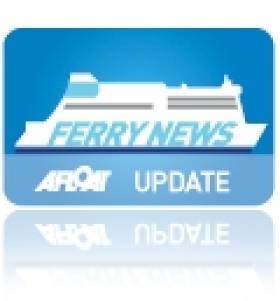Displaying items by tag: Dun Laoghaire Harbour Company
Dun Laoghaire Harbour Chief Lodges High Court Action Against Company
#DunLaoghaire - Dun Laoghaire Harbour Company chief executive Gerry Dunne has lodged High Court proceedings against his employer, according to Sunday Business Post business correspondent Jack Horgan-Jones in yesterday’s edition of the paper.
Dunne, who was appointed CEO in 2009, spearheaded the ‘masterplan’ for regeneration of the south Dublin harbour that has in recent years lost its long-time passenger ferry link to Britain.
Under Dunne’s oversight, plans for the harbour have included a now-cancelled diaspora centre, an ‘urban beach’ project that received planning permission in mid 2015 but was not realised as expected this summer, and a new cruise terminal to accommodate next-generation liners that was at the centre of oral hearings last year.
More recently, the possibility of hosting a floating hotel or ‘flotel’ in the harbour has been mooted.
However, Horgan-Jones writes that these ambitious projects have been subject to “reservations at the highest level of government”, with one civil servant raising concerns about the soundness of the harbour’s corporate plan.
In response to our request for comment, Dunne said that the precise matter of the High Court action is currently sub judice.
Dun Laoghaire Harbour Transfer Going Ahead, Is Best Move For Its Future Says Minister
#DunLaoghaire - The Transport Minister maintains that transferring the operation of Dun Laoghaire Harbour to the local authority is the best move for its sustainable development.
Responding to a Dáil question earlier this month from Dun Laoghaire TD Seán Barrett, who asked for clarity on the future of the South Dublin port, Minister Shane Ross confirmed that it is still designated for transfer to Dun Laoghaire-Rathdown County Council.
However, the minister also acknowledged the "dispute about the ownership and future model" for the harbour, which stems from Dun Laoghaire Harbour Company's reaction to changing commercial and economic conditions, such as the withdrawal of the Stena Line ferry service, which saw profits sink in 2015.
"My department is aware that the ongoing challenge for the port will require sustained effort across a number of fronts," he said. "This may even involve the sale of some non-strategic assets."
Other potential projects include the recently tendered 'flotel' concept, which is now seeking expressions of interest.
The minister did not respond to Deputy Barrett's assertions that the local authority has neither the expertise nor management structure to run the port effectively.
More recently, Minister Ross answered a request for statement from Dun Laoghaire TD Richard Boyd Barrett, who again raised the issue of anomalies in executive payments by the harbour company, as well as concerns over alleged pension scheme irregularities ahead of a meeting between company trustees and the Pensions Board next week (Wednesday 27 July).
Noting that there was "obviously a misunderstanding or certainly a conflict of evidence" regarding legal acton to recover expenses paid to a former board member, the minister said that he could not comment on the matter and that his "powers in this particular matter are limited".
However, he welcomed the opportunity for meeting with any stakeholders Deputy Boyd Barrett might arrange.
Dun Laoghaire Harbour Company Seeks 'Flotel' Operator
Dun Laoghaire Harbour Company is seeking expressions of interest to operate a “Flotel” in Dun Laoghaire Harbour.
According to a notice posted yesterday on the Goverment's etender website, operators are sought to run a “Flotel” in Dun Laoghaire Harbour. Responses, according to the notice, are required by July 26th. The link to the notice is here.
Harbour Company executive Carolyn Hanaphy has told Afloat.ie that the company 'enivsages a five star cruise ship as a flotel in the harbour', such as the SunBorn flotel in Canary Wharf, London.
Flotels are typically used as hotels on rivers or in harbour areas, or as accommodation for workers. They are also used in the offshore oil industry, mining industry or in environmental or natural emergencies.
Flotel accomodation varies but the Sunbourn example cited by DLHC features 'Polished, classic rooms have en suite bathrooms and feature flat-screen TVs and free WiFi, plus touch-pad room controls'. is The upgraded yacht, moored at London's Docklands, also has suites add sitting areas or living rooms and soaking tubs.
Meanwhile, Dun Laoghaire Harbour Company is awaiting a decision by an Bord Pleanala on its proposals for a new cruise liner berth in the harbour.
There is little or no regular commercial traffic at the harbour since the withdrawal of the Dun Laoghaire – Holyhead Stena service, a route that had a 200–year history.
 Amsterdam's botel
Amsterdam's botel
Harbour Master – Dún Laoghaire Harbour Company Ltd
ADVERTISEMENT:
Our client, Dun Laoghaire Harbour Company Ltd., is at a significant stage in implementing its Masterplan.
The company is seeking to recruit a successor to the current Harbour Master, who is due to retire shortly.
The Harbour Master will be required to maintain a safe port, ensure that all statutory, regulatory and conservancy duties are carried out, enforce Harbour Bye-Laws and Regulations, levy rates and charges, manage port emergencies, and the port environment, and ensure compliance with safety and other relevant legislation.
The Harbour Master will be a member of the Dun Laoghaire Harbour Management Team.
The successful candidate must hold an Irish or UK Certificate of Competency, Class 1 (Master Mariner), and also have at least 5 years relevant industry experience.
Please apply by sending your CV to:
Robert Ferry
RFC Executive Recruitment
406 The Capel Building
St Marys Abbey
Dublin 7
Email: [email protected]
Closing date for receipt of applications, 4th April 2016
Is The Future Of Dun Laoghaire Harbour Being Held Hostage?
As Dun Laoghaire residents await An Bord Pleanála's decision on the controversial cruise liner berth proposed for the town's harbour, local banker Paddy Shanahan took a look at the books of the Dun Laoghaire Harbour Company (DLHC) – and finds the whole situation wanting. Harbour CEO Gerry Dunne's response is also posted below.
I am a banker with over 30 years' experience working in New York and London. I have recently returned to Ireland. I am married with two small boys and I run a corporate finance and restructuring practice here in Dublin. I live in Sandycove and am part of Dublin Bay Concern, an organisation comprising many residents of Dun Laoghaire-Rathdown (DLR).
My concern relates to the future status of the Dun Laoghaire Harbour Company (DLHC). I am opposed to the planned super cruise berth terminal for the harbour and to the Masterplan submitted by the DLHC. An Bord Pleanála is currently deliberating on DLHC’s application following a month-long oral hearing.
Meanwhile, the Harbours Bill 2015 was recently introduced into the Oireachtas. This bill will decide the future of DLHC. We are presented with two options, one of which will be decided by Minister for Transport Paschal Donohoe:
a) DLHC becomes a wholly owned subsidiary of the chief executive DLR CoCo.
b) DLHC is dissolved and integrated into DLR CoCo.
On a matter of profound importance to the residents of DLR and to the hundreds of thousands who use the harbour as an amenity every year, there has been little to no communication by the relevant elected representatives back to their constituents on this matter, excepting Richard Boyd Barrett and his party People Before Profit.
Difficult financial situation
On my own volition, I obtained copies of DLHC’s accounts from 2012 to 2014. I have analysed these accounts and found the following:
DLHC’s financial position has been declining in recent years. In 2012 the company’s cash reserves declined by €2.0m and in 2013 by a further €1.3m. The decline in cash was much smaller in 2014 (€37,000) thanks to the receipt of a €406,420 grant, the provenance of which and use for is unidentified in their accounts.
At the end of 2014, DLHC had cash reserves of €3.5m. With no revenue from the Stena HSS in 2015, remaining cash reserves of €3.5m are rapidly dwindling.
DLHC had bank loans of €4.8m at the end of 2014 for which it does not appear to have sufficient cash or the prospect of sufficient cash to repay in future years.
Based on the above facts, it is clear to me that DLHC is in a difficult financial situation and has neither the reserves nor the ability to borrow the funds required to build the proposed cruise berth.
Notwithstanding its precarious financial position and ignoring the implications to the well-being of Dun Laoghaire Harbour, DLHC wishes to roll the dice and stake its future on providing giant cruise berth facilities – this despite the reality of Dublin Port.
Less than 5km from Dun Laoghaire, Dublin Port is a highly profitable world-class shipping port, and it is the preferred cruise ship destination offering quick access to Dublin city centre. It already receives over 80 super-sized cruise ships a year and has recently received planning permission to begin a €200m development which will double its large cruise ship capacity together with a state-of-the-art modern passenger terminal specifically being built for visiting cruise liners.
DLHC proposes a collusive duopoly for the cruise ship business with Dublin Port. Not only is this stupendously naïve, it is also illegal for State-owned bodies to distort the competitive environment, and elegantly demonstrates the flawed business case DLHC proposes – especially in light of the Stena HSS departing for good under DLHC’s watch.
'A likely white elephant'
The Code of Practice for the Governance of State Bodies issued by the Department of Finance in March 1992 and updated October 2001 states that:
“As the ultimate owners of, and investors, in State bodies, citizens and taxpayers have an important and legitimate interest in the achievement of value for money in the State sector. Whether commissioning public services or providing them directly, State bodies have a duty to strive for economy, efficiency, transparency and effectiveness in their expenditure.”
In 2012 and 2013 DLHC received €250,000 and €200,000 in grants from Dun Laoghaire-Rathdown County Council (DLRCoCo) in respect of DLHC’S Large Cruise Liners initiative. The former was for tendering facilities outside the harbour mouth; the latter was toward defraying costs relating to the planning application.
If it transpires that the €400,000 grant unidentified in the accounts for 2014 was from DLRCoCo, then it would appear that nearly €1m of DLR taxpayers' money has been paid over by the council toward the planning costs of building a likely white elephant.
Is it unreasonable to posit a conflict of interest where the executive branch of DLRCoCo making the payments to DLHC houses the same department that approved the planning application currently being decided by An Bord Pleanála? Is this like Hamlet without the prince? Have DLHC fulfilled their obligations under the code regarding transparency and governance? Clearly not. Where is the oversight? There isn’t any.
Allowing true oversight
Addressing the Dáil on the occasion of the Harbours Bill 2015 debate on amendments last Wednesday 2 December, Minister Donohoe specified there is to be an undefined period of due diligence and examination of DLHC prior to its future being decided by himself.
In the interests of democracy let us hope the minister dissolves the DLHC and transfers its unencumbered assets to the local authority, thus allowing true oversight and accountability.
Given the close relationship and history between the non-elected executive branch of DLRCoCo and DLHC, a decision by the minister that makes the DLHC a wholly owned subsidiary of the chief executive will be a step backwards and simply perpetuates the current unsatisfactory status quo.
The future of Dun Laoghaire Harbour should be decided by the elected representatives of DLRCoCo, the harbour’s genuine stakeholders, and its various community groups.
Dun Laoghaire Harbour, dear to the hearts of all residents of DLR, is being held hostage to the ambitions of a dysfunctional organisation that is running out of money and being supported in a clandestine manner against all principles of transparency and governance.
Response from Dun Laoghaire Harbour Company CEO
DLHC has decided that it is not appropriate to make further public comment while An Bord Pleanala is considering our planning application.
Suffice to make the following brief points ;
[a] the European Commission have stated that the grant of €20m towards the Dublin Port development is made on the basis that such support is not given to dedicated infrastructure and facilities for cruise ships. Therefore, Mr Shanahan is fundamentally incorrect in his belief that Dublin Port can provide dedicated cruise infrastructure/facilities
[b] Mr Shanahan might be very interested to know that the four Dun Laoghaire yacht clubs combined make only a very minor financial contribution of c.€70k annually towards the upkeep/maintenance of the infrastructure of the 200 year old man-made harbour. This annual contribution constitutes less than 2% of our annual operating/capital costs.
Gerry Dunne, CEO DLHC
#urbanbeach – Dún Laoghaire Harbour Company hopes to be in a position to open a floating swimming pool and urban beach at the historic East Pier of the Harbour for the 2016 summer season.
Permission was granted in late-2014 by Dún Laoghaire Rathdown County Council, but had been appealed as Afloat.ie reported at the weekend.
The project has been inspired by the popular Badeschiff facility in Berlin, a floating swimming pool on the River Spree. The plan for Dún Laoghaire Harbour includes a floating swimming pool containing heated and treated seawater, utilising a converted river barge which will be located within the Harbour. The facility will include an Urban Beach alongside the floating structure, on Berth 1 adjacent to the East Pier. Changing and toilet facilities, a café, an administration area, and security features are also planned.
The Harbour Company estimates that urban beach has the potential to attract 100,000 visitors per year and to generate over €1 million per annum for the local economy.
Dún Laoghaire Harbour Company hopes to be in a position to open the facility for the summer season in 2016.
According to Tim Ryan, Operation Manager, of DLHC: "Today's go-ahead by An Bord Pleanála is very welcome, and marks a vital step in realising the full potential of the Harbour as a marine, leisure and tourist destination of international calibre."
"The urban beach will be a hugely exciting project for Dun Laoghaire as a while. It is very much in keeping with the Government's National Ports Policy which designated Dún Laoghaire as a harbour focusing on marine leisure, marine tourism, and urban development. Today's decision allows us to follow through on our mandate.
Over the coming months, Dún Laoghaire Harbour Company Harbour is set to welcome a record 100,000 cruise passengers and crew. "Combined with the news of the urban beach, the future for Dun Laoghaire Harbour is really shaping up, as set out in the Company's Masterplan of 2011," added Tim.
#dharbour – RESPONSE TO PUBLIC COMMENTARY ARISING FROM STAKEHOLDER/PUBLIC CONSULTATION EXERCISE HELD IN MARCH/APRIL 2015 CRUISE BERTH PROJECT AT DUN LAOGHAIRE HARBOUR For DUN LAOGHAIRE HARBOUR COMPANY ON BEHALF OF THE DUN LAOGHAIRE CRUISE STAKEHOLDER GROUP
The Dun Laoghaire Cruise Stakeholder Group has responded to concerns raised in a number of submissions made as part of an informal pre-planning consultation process in connection with the proposed development of a new cruise berth facility in Dún Laoghaire Harbour.
It is expected that a formal planning application for the proposed development will be submitted to An Board Pleanala in the coming weeks.
As part of the consultation process the Cruise Stakeholder Group met and briefed local public representatives and stakeholder groups. Full details of the proposal were posted on the Dún Laoghaire Harbour Company website and all those on the company's database were written to. Posters were also erected in the harbour area inviting members of the public to submit their views.
A total of 139 submissions were received. The submissions offered a variety of views, including positive support for the project. A large number of submissions expressed some concerns, and indeed opposition to the project. In some cases opposition / concern was based on a misunderstanding of what was actually proposed or had misplaced concerns about the implications for harbour users.
The Dún Laoghaire Cruise Stakeholder Group is committed to taking into account all submissions made before the planning application to An Bord Pleanála is finalised.
However, in order to address concerns that were raised, the Stakeholder Group has now published a short document summarising the main issues which arose during the informal pre-planning consultation process, along with a succinct response to each issue. A summary of the issues and responses will also available on the Harbour Company's website. This document is now being issued to all those who made submissions, to public representatives and to stakeholder groups. [Scroll down to read this document]
The Dun Laoghaire Harbour Masterplan, published in 2011, identified the need to develop strategies to ensure the long term future of the harbour, in view of the declining importance of ferry traffic. Development of cruise business was identified as one of the opportunities to be pursued. In addition, Dún Laoghaire is designated as a marine tourism port under the Government's National Ports Policy and the development of the cruise business fits into this framework.
Dún Laoghaire will have its most successful cruise season ever in 2015, with 100,000 passengers and crew expected. However the development of the cruise berth facility is essential to allowing up to build on the success to date and to bring even more vessels and passengers to our town.
The expansion and development of the cruise business offers significant economic benefits to Dún Laoghaire and the surrounding areas. These would include expenditure by disembarked passenger and crew; payments to tour operators by cruise companies and purchases by cruise ships from local supplies while in harbour.
The Dún Laoghaire Cruise Stakeholder Group is confident that the cruise berth development can be delivered while preserving the unique heritage of the harbour and without impacting unduly on sailing and marine leisure activities which are such significant parts of the harbour's activities.
Introduction
The Dun Laoghaire Harbour Company on behalf of the Dun Laoghaire Stakeholder Group in the process of compiling a planning application to be submitted to An Bord Pleanala under the Strategic Infrastructure (SID) provisions of the Planning & Development Act 2000, as
amended.
As part of that process it was decided to canvass the views of local people prior to making the planning application in order to seek to accommodate or ameliorate any issues that may arise as part of the application. This was referred to as a 'Phase 1 Consultation'.
The undertaking of this exercise and any involvement in same would not affect people's rights to participate in the planning application process in the normal way.
Phase 1 Consultation
A presentation was prepared in order to provide an over view of the project in terms of what it involves (both during construction and operation), the work undertaken to date and an explanation of the application process that would follow.
A set of Frequently Asked Questions (FAQ's) and responses was prepared in anticipation of the typical queries that would arise.
A page on the Harbour Company web site was set up which included the above presentation, together with accompanying maps of the harbour, along with the FAQ's. This information was available for download.
It was intended to have a two week period in which members of the public could make their views known. The Harbour Company used its database of stakeholders to send a letter inviting participation in this Public Consultation phase. In addition, posters were erected around the Harbour so that Harbour Users would see the consultation was on-going and could participate.
Prior to commencing this Consultation, meetings were arranged with key stakeholders/Harbour Users. These meetings took place in the last week of March 2015.
Overall, the Stakeholder/ public consultation process occurred over a three week period. There have also been a series of meetings both with Dun Laoghaire Rathdown County Council and An Bord Pleanala relating to this project. Those consultations occurred separately to this public consultation process.
Who did we meet?
The following is a schedule of the meetings held prior to the Public Consultation process
commencing:-
Monday, 23rd March:
• Dun Laoghaire Area Committee, Dun Laoghaire Rathdown County Council
Tuesday, 24th March:
• St Michael's Rowing Club
• Sea Scouts/ Kyron O'Gorman
• Irish National Sailing School
• Dun Laoghaire Motor Yacht Club
• Royal National Lifeboat Institution (RNLI)
Wednesday, 25th March:
• Coal Harbour Users Group
• Marina Company
• Dun Laoghaire Business Investment District Company
• Commissioners of Irish Lights
Thursday, 26th March:
• National Yacht Club
• Dublin Bay Sailing Club
Friday, 27th March:
• Royal Saint George Yacht Club
• Royal Irish Yacht Club
Wednesday 1st May 2015
• The Water Wags
Number of responses
In total 139 responses were received during this Phase 1 Consultation phase. Of these, 13 were in favour of the project, 22 made observations or raised queries and the remainder were against, with a variety of issues raised.
In general only a minority of submissions were supportive, some simply raised questions of made broad comment, but the majority expressed opposition to the proposal; in some cases these were based upon a misunderstanding of what was in fact proposed, or misplaced about the implications for harbour users.
What were the issues raised?
In seeking to provide a response at this stage, we have attempted to group common issues under particular headings. This avoids too much repetition in the responses provided below.
From a review of the Submissions made, the following issues arose:-
1. Impact on dingy sailing/youth sailing
2. The cruise berth cuts the harbour in two.
3. Impact on sailing competitions in the harbour
4. Impact on ability to attract International sailing competitions
5. "Wind shadow" effect of cruise ship in harbour
6. Impact on Heritage of the harbour
7. Suitability (or otherwise) for a Victorian harbour
8. Potential for environmental damage and negative impact on bird and marine life
9. Safety/emergency incident plan
10. Rocky nature of harbour bed making dredging difficult
11. Disturbance to mercury in the harbour bed caused by dredging
12. No economic benefit to the town
13. Impact on traffic
14. Legal advice that project is not Strategic Infrastructure Development
15. Too little detail provided about the scheme
16. Consultation period too short
17. Replacement ferry service for Stena
18. Leave cruise business to Dublin Port.
19. Continue with existing cruise tendering operation (ships anchoring in Dublin Bay)
20. DLHC should not be allowed embark on a new venture like this, while a merger with DLRCoCo is pending
Dinghy sailing/youth sailing
It is evident from a review of the comments received that the issue which arose the most often was the impact the proposal would have on Dinghy Sailing/Youth Sailing. In particular, the following activities were raised:-
• Junior Summer Sailing Courses
• Sailability Dun Laoghaire
• Friday Night Racing
• September Series
• Regional and National Optimist Class Championships
• Junior Sailing Regatta's
• ISA National and Regional squad clinics
• Team Racing
• Winter Frostbite Racing
• Summer Tuesday Night Racing
• Winter Coaching
• Dun Laoghaire Regatta
We will have regard to the aspects associated with each of these within the planning application.
Preliminary response to issues
The issues raised through the public consultation exercise will be addressed in a full and comprehensive way as part of the plans and particulars to be lodged with An Bord Pleanala.
At the outset, it is worth recalling that Dun Laoghaire Harbour is first and foremost a working harbour. It also happens to accommodate a marine leisure component which it is recognised and acknowledged contributes to its charm and character. It is also recognized that the marine leisure component of the harbour is a significant part of the harbour activity. This marine leisure activity must and does function in a manner that does not detract from the primary function of the harbour.
To that end, it is worth highlighting that activities within the Harbour are carefully managed and controlled in line with long established rules, referred to as the Notices to Mariners and the Harbour Bye-Laws.
With that in mind, the following provides an initial response to the principal issues raised by members of the public and harbour users generally.
1 Impact on dingy sailing/youth sailing
At present, most harbour users ultilise the harbour as a transit zone between the shore and the bay, where the vast majority of sailing activities occur. This occurs in line with the normal restrictions applying within the Harbour. It is acknowledged that traditionally junior training has taken place in the harbour. All such activity requires the approval of the Harbour Master.
The Notice to Mariners No. 4 defines the Training Area for junior sail training. It states:- "Harbour Recreational Area for Small Craft is the triangular area of the North Bightwestwards of a line from West Pier Lighthouse to the marina west breakwater". Use of the remainder of the harbour by small craft is otherwise restricted, unless and until 'permission' has been obtained. With the removal of swing moorings in 2014, the North Bight area available for raining has been considerably enlarged which has benefitted junior training in the harbour. This will be unaffected by the proposed cruise project
Notwithstanding the Notice to Mariners No. 4, it is recognized that the very junior sailors/beginners associated with the NYC and RSGYC have utilized the sheltered water space immediately around the Carlisle Pier and St. Michael's Pier to learn to sail. Both the IYSC and the INSS use the designated training area at the North Bight.
When competent, the junior training regime then moves from around the piers, to the formal training area and then out to the bay. The INSS use both the Coal Harbour and Seapoint Beach, as well as using the designated training area.
The tradition over the past 15 years or so has been that the more senior/experienced juniors use Dublin Bay itself to train.
It is Dublin Bay that is the 'Major Area of Excellence for Sailing' and the sailing areas that are available now will be available after any cruise berth project has been installed. The designated training area in the North Bight has recently (2014) been extended and will continue to be available.
It has been suggested in a number of submissions that the provision of the cruise berth will prevent the harbour being used for sailing and other marine activity. This argument does not stand up to closer scrutiny. Whilst it is fully acknowledged that the facility will result in some change to the existing patterns of activities for some users, others will see little or no change.
Traditionally, there has been very little 'racing' inside the harbour, other than by the Water Wags, DBSC and the DMYC Winter Series and this has been 'by permission' only.
2 The cruise berth will cut the harbour in two The cruise berth will extend northwards from the existing marina breakwater, from a location to the west of the existing HSS berth.
Even though the berth structures are significant, to allow the berth to accommodate the type of large cruise ship that the cruise lines now favour, there will be a considerable expanse of water within the harbour, north of the northernmost extremity of the proposed berth, which will allow unimpeded travel for boats between the eastern and western areas of the harbour. The total distance from the marina breakwater to the West Pier roundhead is about 0.66 kilometers (660m). The berth will extend northwards for just under two thirds of this distance, leaving just over one third remaining for cross harbour activity.
In addition to the above, the proposed berth will include an underpass which will allow passage between the marina and the areas to the east of the harbour without the need to go around the berth. This underpass will be suitable for use by ribs, launches and other small non-masted craft.
3 Impact on sailing competitions in the harbour There are in fact only a very small number of sailing competitions in the harbour and these occur at particular times of the year only.
As previously noted, all activities within the harbour are subject to an approval process. It is considered that with the adjustments made to the swing moorings at the East and North Bights in recent years that it should be possible for these limited competitions to continue to use the harbour. The Harbour Company is committed to working with the race organisers to find a viable solution within the Harbour.
4 Impact on ability to attract international sailing competitions At the outset we would comment that when international sailing competitions have occurred in Dun Laoghaire in the past, this has imposed severe restrictions on other harbour users.
Appropriate restrictions and safeguards were put in place by the Harbour Master and harbour users adjusted their activities accordingly with little or no fuss for those periods. As regards the loss of such competitions due to the cruise berth project being implemented, it is respectfully submitted that this would not be the case. The continued use of the harbour as a transit zone and holding area as occurred with such events in the past could continue to occur when the cruise berth is in place.
5 Wind shadow effect of cruise ship in harbour Large cruise ships at berth will have an effect on the wind patterns locally, and will result in "wind shadow" downwind of the ship.
The affected area will vary depending on a number of factors, including the size of the ship, the direction of the wind and the speed of the wind. No matter what direction the wind is blowing, there will always an area of the harbour that will be windward of ships at berth and therefore unaffected. This unaffected area of the harbour will always be available for dinghy/youth sailing. It will also be possible to sail in the area affected by "wind shadow" on the leeward (sheltered) side of the ship, with the exception possibly of up close to the ship. Winds blowing roughly parallel to the ship will have little or no "wind shadow" effect. Experienced sailors are familiar with the "wind shadow" effect as their sails create "wind shadow" and a knowledge of this effect is used to gain competitive advantage in racing by manoeuvring to put their competitors in the bad wind caused by the "wind shadow" of their boats.
6 Impact on heritage of the harbour
The development being proposed does not impact on any protected structures, nor does it involve the removal of any heritage structures. The proposal involves the provision of a new berth within an existing harbour and is entirely appropriate as a result. It is acknowledged that part of the Harbour's heritage is its use for marine recreational purposes. This aspect of the Harbour use will not be destroyed by the cruise berth.
7 Suitability of proposal for a Victorian Harbour
There have been quite a number of changes to the activities that occur within the harbour since the days it was first built. The harbour has evolved many times as a result. As already highlighted, it is a working harbour. It is a simple fact that it costs a significant
amount of money annually to just maintain the quality and infrastructure of the harbour. Much of the harbour is old and needs on-going maintenance. The Harbour Company is self financing and needs to generate the required income to sustain the harbour in to the future. For clarity, the Harbour Company receives no funding from Government. The cruise berth is precisely the type of facility one would expect to find in a harbour. With the impending demise of the HSS (which has now occurred), the Harbour Company is looking to attract cruise ships to the harbour. The berth will go some way towards ensuring the viability of the harbour in to the future.
8 Potential for environmental damage and negative impact on bird and marine life This particular issue has been extensively assessed as part of the Environmental Impact Statement being finalized at present.
The preparation of this assessment involved extensive discussions with the National Parks and Wildlife Service, including the Marine Department in Galway and has been conducted by a firm of specialist ecologists. We have been concerned from the outset to minimize any impact the proposal might have on birds or marine life generally and have devised a construction methodology specifically intended to address this.
9 Safety/Emergency Incident Plan
As a working harbour, we can confirm that Dun Laoghaire Harbour has an Emergency Management Plan in place at present in line with the tenets of "A Framework for Major Emergency Management". The current Emergency Plan can be adjusted to take account of the cruise berth facility. The Plan already caters for cruise ship tendering. A Risk Assessment and SOP are in operation for present cruise visits and will be adapted for berth usage.
10 Rocky nature of harbour bed making dredging difficult
As part of the preparatory investigation and survey work undertaken for the project, a programme of ground investigation work was undertaken which included the drilling of boreholes into the seabed in the areas where the proposed berth would be constructed and in the areas to be dredged. It was found that rock was generally located well below the existing seabed and the proposed dredge level. It is therefore not envisaged that any rock or hard material will need to be dredged for the project. This is consistent with the findings of previous investigations in this area of the harbour.
11 Disturbance to mercury in the harbour bed caused by dredging
The area which will require dredging has been the subject of extensive ground investigations as part of the scheme design and Environmental Impact Statement process relating to the project. No elevated levels of mercury have been identified We are aware that mercury has historically been found in other parts of the Harbour near the Coal Harbour. No dredging or marine works are planned for the Coal Harbour as part of this project and as a result no disturbance to the ground conditions will arise.
12 No economic benefit to the town
The Stakeholder Group has commissioned a firm of economic consultants to look in to the economic impacts of the project. Their findings show that there is the very real potential for the town to benefit directly and significantly from the arrival of cruise visits to Dun Laoghaire.
It is estimated that the net economic impact of doing the project for Dun Laoghaire town will lie between €16m and €41m after twenty years, depending on the number of vessels coming into Dublin Bay. The lower number assumes a continuation of historical growth trends in the Dublin Bay market, while the upper limit represents a replication of the success of Copenhagen.
It is recognized that the businesses of the town need to embrace the potential for additional revenue arising from the visiting cruise passengers for this process to be a success. The Cruise Stakeholder Group are confident that Dun Laoghaire will maximize this potential in the years to come.
13 Impact on traffic
The traffic associated with the planned cruise project has been assessed as part of the Environmental Impact Statement process. This shows that the surrounding roads and streets are capable of catering for the traffic associated with the project with relative ease. The project will involve a modest number of coach trips at particular peak periods in the day.
Previously when the HSS was operating five sailings per day (arriving and departing), there was significantly more traffic movements in the area of the project.
It is also worth recalling that there was no particular traffic difficulties with the cruise visits to Dun Laoghaire last year and again when the Royal Princess visited Dun Laoghaire on the 12th May 2015 (3,600 passengers and 1,350 crew). Overall, we are confident that the traffic associated with the cruise project can be catered for
on the existing road network with minimal disturbance.
14 Legal advice that project is not Strategic Infrastructure Development
The project contains a new cruise berth that is greater than 100m in length capable of catering for the new generation of cruise vessels. The Seventh Schedule of the Planning & Development Act 2000, as amended includes a project involving a new berth in a harbour of 100m or more in length as being a project for which the provisions known as strategic infrastructure applies. In line with the requirements of the Act a dialogue with An Bord Pleanala to determine whether the project is or is not strategic infrastructure was commenced in May 2013. An Bord Pleanala have now confirmed in writing that the project is strategic infrastructure and have directed the planning application to be made to An Bord Pleanala directly.
15 Too little detail provided about the scheme
We would respectfully suggest that a significant amount of detail regarding the project was provided at pre-consultation and as part of the consultation. The final project design is nearing completion, as is the EIS that is intended to accompany the application. The outcome of this pre-application public consultation will feed in to the final plans. The full and final detail of the scheme will be available for interested members of the public on a dedicated web site and will also be available at the offices of Dun Laoghaire-Rathdown County Council during the seven week consultation period after the planning application is lodged with An Bord Pleanala. The application will also be available in the offices of An Bord Pleanala.
16 Consultation period too short
The stakeholder/public consultation period took place over a three week period. This was considered adequate to obtain the views of people towards the project. It was made clear in the material provided at this stage of the process that a further much lengthier and formal process of consultation would follow once the planning application for the project was lodged.
The response to the request for comments generated 139 submissions. There will be a full seven week consultation period once the planning application is lodged, during which time observations to An Bord Pleanala may be made. This will afford interested parties with a further opportunity to comment on the final proposals.
17 Replacement ferry service for Stena HSS
We can confirm that the Harbour Company is in discussion with potential ferry operators. Were a ferry service to return to Dun Laoghaire, it would only be a small craft service catering for small numbers of cars and foot passengers. It is not envisaged that by the operators that vessels capable of accommodating freight traffic will come to Dun Laoghaire again. Such a small craft ferry could operate in the harbour in tandem with a cruise berth facility.
18 Leave cruise business to Dublin Port
The National Ports Policy (2013) identifies Dun Laoghaire Harbour as follows:- the long-term future of Dún Laoghaire Harbour Company will be in terms of marine leisure, maritime tourism, cultural amenity and urban redevelopment. The cruise industry will have a major part to play in the realization of these national policy
aspirations for the harbour. It is considered entirely consistent with National Ports Policy to encourage cruise visits to Dun Laoghaire Harbour. It is considered that there is scope for both Dun Laoghaire Harbour and Dublin Port to cater for the increasing cruise industry in Dublin Bay.
19 Continue with existing cruise tendering operation (ships anchoring in the Bay)
Cruise lines will always favour direct berthing to tendering, as it offers a better experience for its passengers and is more reliable. Tender berthing requires a long transit from ships anchored a couple of kilometres outside the harbour in small tender boats. The transit time to and from the ship means that the time available for passengers ashore is shorter than would be the case if the cruise ship were able to berth within the harbour. It is also subject to weather conditions, as conditions may be such that the journey in the tenders is uncomfortable due wind and wave conditions, or indeed, weather conditions are such that it is deemed unsafe for passengers to disembark from the cruise ship onto the tenders, so the visit to Dun Laoghaire is cancelled. A smaller proportion of the passengers and crew on board the cruise ships will come ashore if the ships tender in Dublin Bay than if the ships berth in the harbour and passengers can disembark onto a quay. The provision of a direct berth will attract a greater number of cruise ships, and a greater proportion of passengers aboard those ships will come ashore to explore Dun Laoghaire and its surroundings, as it is easier to come ashore and to get back onto the ship, providing a greater benefit to Dun Laoghaire and
the greater Dublin area.
20 DLHC should not be allowed embark on a new venture like this, while a merger with DLRCoCo is pending
The project promoter is the Dun Laoghaire Cruise Stakeholder Group. The three principal members of this Group are; Dun Laoghaire Harbour Company, Dun Laoghaire-Rathdown County Council and the Dun Laoghaire BID Company.
The planning application is being made with the approval and assistance of Dun Laoghaire- Rathdown County Council which approved the initial expenditure at a Council Meeting in July 2013. Officials from Dun Laoghaire-Rathdown County Council have attended the majority of the project meetings held with An Bord Pleanala and have expressed their support in principle for the project.
#sdls – A new group, Save Dun Laoghaire Sailing (SDLS), has come forward with radical proposals for a re-configuration of the harbour in order to accommodate the proposed Cruise Liner Berth in the harbour, (plans of which were revealed on Afloat.ie last Thursday), while at the same time maintaining the town's pre-eminent role as Ireland's greatest sailing centre.
A spokesperson for SDLS said that the new group's proposals were still only at a very preliminary stage, but the extremely short time lapse permitted for objections or modifications to the Harbour Company's plan has meant that they have had to act in great haste.
However, the spokesperson asserted that the harbour's thousands of recreational sailors are so concerned at some elements of the new plan - such as the rumoured intention to forbid boats manoeuvring under sail only, let alone racing, within the harbour – that they have had no trouble in recruiting supporters, and an ad hoc inaugural meeting in recent days instructed an acting committee to proceed as rapidly as possible.
The underlying thinking behind SDLS's proposals is that the areas of activity for the different interests within the harbour should be clearly delineated. "Good fences make good neighbours" is the group's core philosophy, and with this in mind they have proposed two new in-harbour breakwaters in order that the large area in the centre of the harbour, which is intended for use by the new cruise liner berthing facilities, will be walled off from other areas of the port.
This will be done by a new in-harbour breakwater from St Michael's Pier to the outer end of the present East Pier, and another small in-harbour breakwater closing off the present outer entrance to the marina.
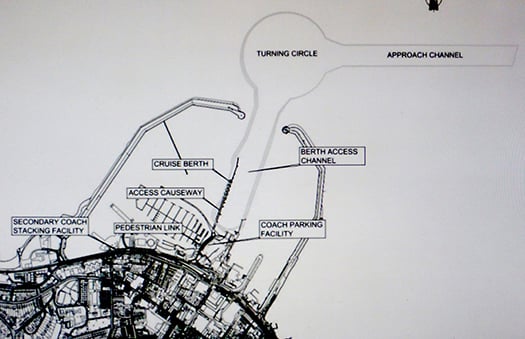
Dun Laoghaire Harbour with the Harbour Company's proposed Cruise Liner Berth occupying most of the space between St Michael's Pier and the harbour entrance

Radical proposals from SDLS (Save Dun Laoghaire Sailing) include new Eastern and Western entrances to the harbour, and two new in-harbour breakwaters which will clearly separate the cruise liner areas from the recreational sailing and boating areas. In effect, three new harbours will be created.
In order to make this feasible, the group has come up with the visionary concept of giving Dun Laoghaire Harbour two additional entrances. The new entrance to the east would be created by making a gap in the existing East Pier, and would inevitably be expensive, as this is exposed to onshore winds, and thus would require a very substantial sheltering breakwater. However, it would still be as cost-effective as possible, as this new Eastern Entrance would not need to be nearly as wide as the current main entrance, as that was created in order to be negotiated by the cumbersome sailing ships of the early 19th Century.
When Afloat.ie pointed out to the spokesperson (who wishes to remain anonymous for the time being) that a gap in the East Pier would result in the ending of the time-honoured tradition of South Dubliners walking the length of the pier on a Sunday, the response was that the demographic is such that an increasing number of South Dubliners are so aged as to be no longer capable of walking the entire length of the East Pier, and thus they would welcome the shorter walk to the lighthouse which will be provided by the new inner breakwater direct from St Michael's Pier.
A further question about the need for manoeuvring space for the cruise liners between their proposed berth and the East Pier elicited the reply that the Harbour Company have already made it clear that they will have to dredge a ten metre channel from the present main entrance to the new berth to serve the deeper drafted liners. Therefore the building of a new pier along the eastern edge of this dredged channel will not impinge on the cruise liners' area of access, and will moreover restrain small craft which might be sailing or racing in the eastern harbour from straying into the liner area.
SDLS is particularly enthused about the possibilities offered by he new western entrance. "For far too long, the West Pier has been more like the Wild West Pier than part of a civilised harbour," we were told. Now, with the new entrance, it will be brought centre stage, and those dinghy sailors from the RIYC, the DMYC, the INSS and the Coal Harbour who were formerly reluctant to venture into the open waters of Dublin Bay will find they have easy access to the relatively sheltered Bay waters between the West Pier and Seapoint.
SDLS conclude their initial policy document by pointing out that their plan would in effect provide the benefit of having three harbours where at present only one exists. And for further diversity, they suggest that the central commercial area for the cruise liners could possibly, in time, also accommodate some working fishing boats, as the colourful activity of hardy fisherfolk is much appreciated by cruise liner passengers
As to the fact that the creation of two new entrances means in effect that there will now be two completely separate leisure harbours on the south side of Dublin Bay with their entrances one and a half miles apart, SDLS argues that this is one of the most attractive features of their plan.
"Sailing enthusiasts from places blessed with natural advantages and numerous little ports of call, such as Cork Harbour, are always bemoaning the fact that when you sail out of Dun Laoghaire, there is nowhere convenient to go to within easy reach. But thanks to our plan, we can now envisage that a boat which has to go to sea via the new West Entrance could go out for a nice sail in Dublin Bay, and then go visiting in the eastern part of the harbour through the new Eastern Entrance, and vice versa.
Having considered these attractive options, we don't see the proposed new cruise liner berth as a problem. On the contrary, we see it as an opportunity to make Dun Laoghaire a much more interesting place to sail from".

Dun Laoghaire harbour largely as it is today, although the presence of the HSS ferry in port is now history and the contentious new library has been inserted in the tree-surrounded green space at right foreground. Photo courtesy ICC.
Editor's Note: Normally our April 1st special would be pulled at noon. But as virtually all plans for a totally artificial harbour at Dun Laoghaire, ever since the first ones more than two hundred years ago, have been initially treated as an April Fool joke, we think we'll let this one run. And further comments are welcome, for underlying the tomfoolery, a very serious situation is developing for the harbour's future.
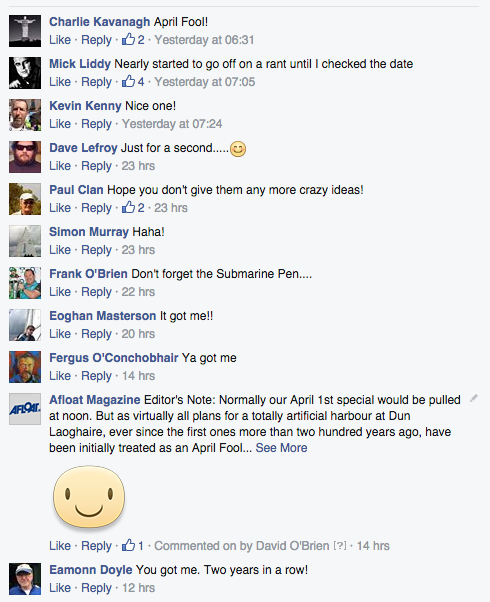
Councillors Look For Control of Dun Laoghaire Harbour Company
#dlharbour – Councillors have made calls for the full executive power of Dun Laoghaire Harbour Company (DLHC) to be given to Dun Laoghaire-Rathdown County Council (DLRCoCo) when it transfers its control to the local authority, according to reports of a council meeting in the Dublin Gazette here.
Details of the handover between the council, the Department of Transport and the company are ongoing since Port changes were mooted by the Competition Authority in 2013. The Cabinet approved the draft General Scheme of a new Bill with important implications for Ireland's vital port sector in June 2014 but since then the precise details of handovers to local authorities appear unclear.
In Dun Laoghaire Cllr Denis O'Callaghan (Lab) submitted a motion calling for control to pass to elected members along with council management when the transfer is complete.
He said: "My concern is that the elected council [members] up to now are being written out of the loop. As representatives, it is reasonable that we should have an input on how one of the largest public spaces in the country [will be run]."
Cllr Victor Boyhan (Ind) said: "We should have central control over the policy and direction. This is our opportunity to grasp this organisation and be fully part of it, going forward."
The council's chief executive, Philomena Poole, said: "At the Oireachtas committee meeting, we asked if it should be a company under executive control or under members' control. Legislation needs to be clear on that; as of yet, that has not been drafted."
She also said it was the shareholding of the company that was being transferred while the DLHC itself would remain as a standalone company. "The main change is that the council will take the place now occupied by the Minister [of Transport, Paschal Donohoe]."
A spokesperson for DLHC told Dublin Gazette: "These are decisions to be made by the Government and we understand they will be addressed in the Harbours (Amendment) Bill, which the Government has indicated will be published before the summer."
More on this story in Dublin Gazette here.
#CancelledHSSsailings- The Dun Laoghaire Harbour Company have responded to Stena Line's announcement that they will not operate the HSS Holyhead-Dublin service as previously reported on Afloat.ie over Christmas 2014 and New Year periods.
It has been the practice of the ferry company to run a limited sailing service on this route at Christmas. Stena has cited 'commercial and operational reasons' for its decision not to operate the service on this occasion.
DLHC is actively engaged in discussions with Stena Line in respect of a seasonal service from 2015. In addition to these discussions, the port company is also heavily focused on building the volume of cruise calls for the 2015 and 2016 seasons, and beyond.
As a core member of the Dun Laoghaire Cruise Stakeholder Group, the Harbour Company has been actively and successfully marketing the cruise potential of the historic 200 year old leisure harbour. It is estimated that Dun Laoghaire will attract in the region of 100,000 cruise passengers and crew next year, with similar numbers already expected for 2016 and 2017.
A planning application under the Strategic Infrastructure Development Act for a new cruise berth for 'next generation' cruise ship is expected to be submitted in the coming weeks to An Bord Pleanala.
According to Gerry Dunne, CEO of DLHC: "While it is regrettable that the HSS won't be sailing out of Dun Laoghaire this Christmas, we look forward to a continued relationship with Stena in 2015 and beyond.
We also look forward to fully exploiting the potential of the harbour as a world-class destination for cruise calls. These developments will have very positive implications for the town of Dun Laoghaire, and the wider hinterland."






























